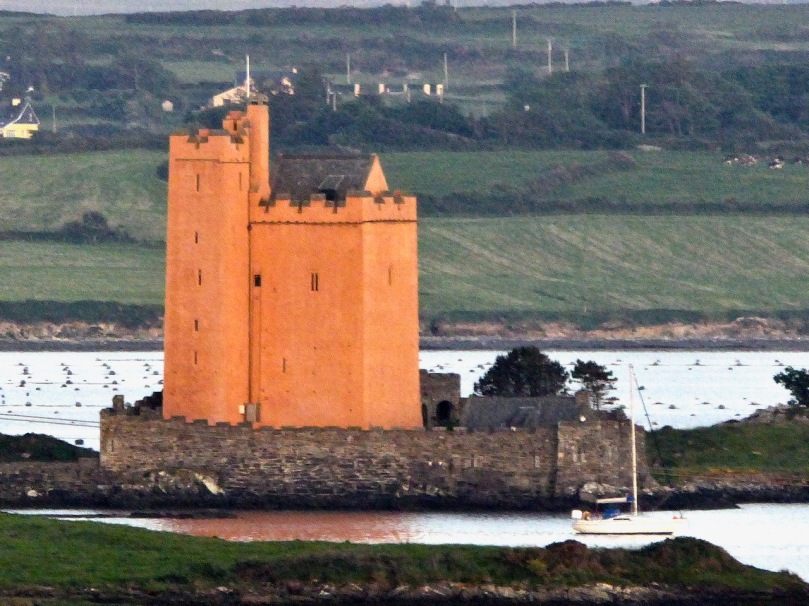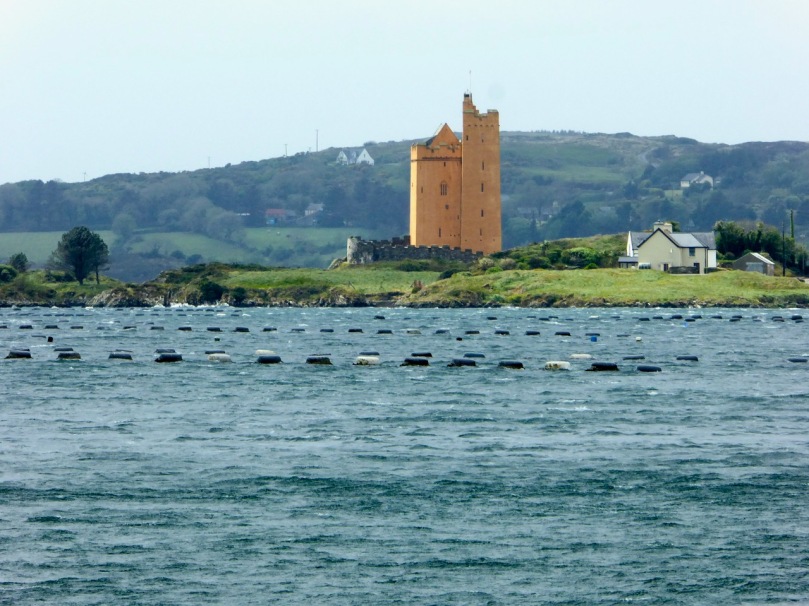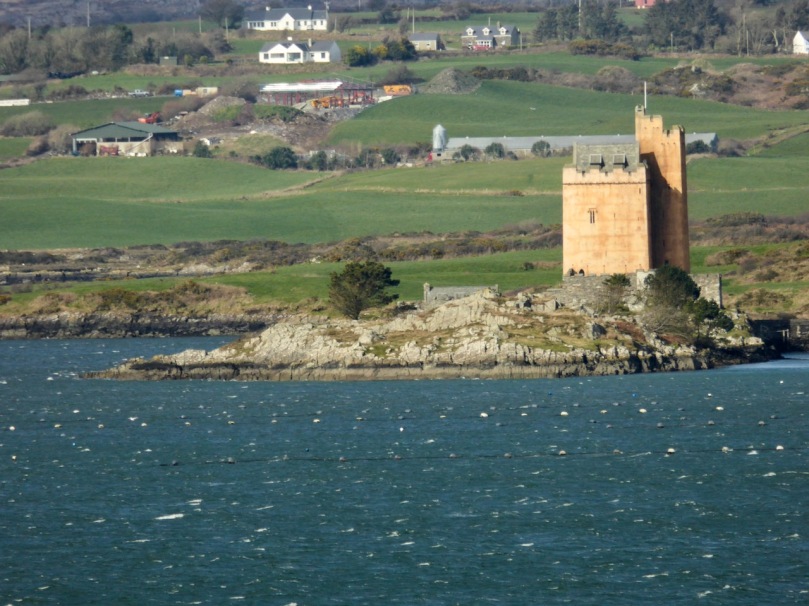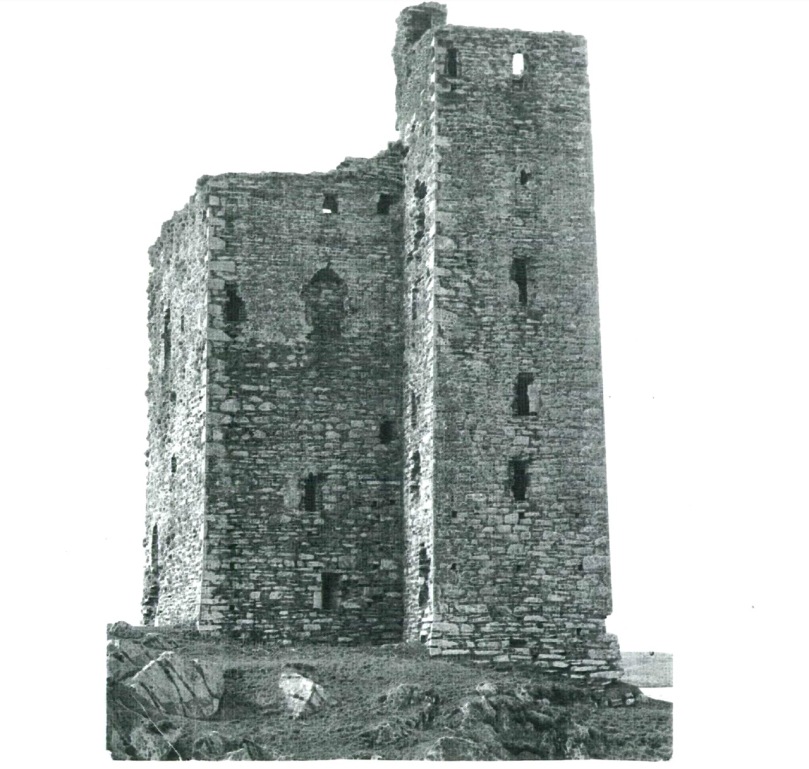Kilcoe Castle has been wonderfully restored and conserved by Jeremy Irons. His work allows us to see what a 15th century castle would have looked like in the landscape and has saved a precious piece of our heritage. This is important as there are so few castles that have been conserved here and lots that have disappeared or are in danger of doing so. Before you read on you might like to refresh your understanding of our West Cork castles, or Tower Houses, by reading When is a Castle?; Tower House Tutorial, Part 1; Tower House Tutorial, Part 2; or Illustrating the Tower House: A Guest Blog (sort of).
First of all, let’s address the issue of the colour of the exterior lime render, since this has been controversial. In fact, the only reason it’s been criticised is that people are not used to seeing castles as they originally stood, since the lime render has long ago disappeared from them, leaving the familiar bare stone walls that people have assumed was how they looked from the start. But all castles were rendered – without that they would have been porous and running with water inside and out.
This is JG O’Donoghue’s reconstruction drawing (used with permission) of what a fifteenth century tower house would have looked like. It was based on Kilcrea Castle. Note the white render and note also that another white castle can be seen in the distance
And the render was coloured! There is evidence of all kinds of additions that would have added colour, including animal fats, blood and hair, flour, shell, sand and stone rubble. The plasterer had his formula and also used what was available locally, materials that would increase cohesion and improve drying time. Irish places names abound in references to coloured castles – just Google the words “castle Ireland” and then put white, black, red, green in front of it and see how many there are. Or look for Irish equivalents, such as Castlederg – for Caisleán Dearg, meaning Red Castle. There’s even a Castleboy in Meath that comes from Caisleán Buí, meaning yellow castle. So the choice of colour was not idiosyncratic or random but well grounded in historical precedents. The render was essential to keep the castle dry and will have to be renewed occasionally as it does eventually wash away – which is why very few examples have survived from the fifteenth century.
The other reason to include colouring elements in the render was to make the castle stand out in the landscape. These were statement residences and the statement was one of power and prestige. They were meant to be seen from a long way off so that nobody could be in any doubt who was the most important person in the neighbourhood. In West Cork, they were also meant to be seen from other castles – those built either by members of the same or another family (the McCarthys, O’Mahonys, O’Driscolls, O’Sullivans or O’Donovans). Kilcoe was a McCarthy castle: the McCarthys were the overlords of all the West Cork clans and this castle was inserted right into the middle of territory controlled by the O’Mahony’s and the O’Driscolls as a constant reminder of the hierarchy. Accordingly, Kilcoe is the largest castle in Roaringwater Bay and has a unique design that incorporates an additional corner tower, distinguishing it from all the other castes around it. There is only one other West Cork castle of the same design – Dunmanus Castle on Dunmanus Bay, a castle of the O’Mahonys.
It was also important that castles could be seen from the water, because control of the fisheries was what gave the great West Cork families their vast wealth. Salted herring and pilchards were staples of the European diet in the Middle Ages because there were so many fasting days on which eating of meat was forbidden and because fresh food wasn’t always readily available in the winter. The O’Mahonys and O’Driscolls catered to the huge fleets of Spanish, French, Portuguese and British fishing boats that plied the waters of Roaringwater Bay, providing, for hefty fees, permission to fish in ‘their’ waters, fish processing facilities and salt in several ‘fish palaces’ along the shore, fresh water, and taverns with fine wines and (sorry) accommodating women. The McCarthy’s must have been involved in this lucrative trade too, but it is also likely that their objective in building Kilcoe was to keep an eye on the the ‘take’ so that they could extract, as befitted those at the top of the food chain, their due share from those who owed them submission and therefore were obligated to yield up hefty donations on a yearly basis.
Castles such as Kilcoe were heavily fortified. Mostly the inhabitants were worried about incursions by other Irish families. It was not until after the Battle of Kinsale in 1601 that the forces of the British Crown came to lay siege to Kilcoe. Thanks to its defensive features and siting Kilcoe was able to hold out longer than any other West Cork castle. The McCarthys abandoned it after Kinsale but an O’Driscoll held on until finally surrendering in 1603. What were the features of this castle that allowed it to resist so successfully?
Fist of all, it was sited on a small island. Like a few other West Cork castles, it was connected by a causeway that could be destroyed at will, cutting off access to the castle. It was surrounded by a strong bawn wall, which is clearly visible now as it has been reconstructed. The wall was punctured by arrow loops and had a wall walk at the top where crenellations provided cover for archers. The roof of the tower also had a wall walk and crenellations – in this case they took the form of what became known as Irish Crenellations. These were stepped or ‘toothed’ battlements, with tall parts (merlons) behind which defenders could take cover and shorter parts (crenels) for shooting from. The crenellations have been expertly reconstructed as part of the restoration of the castle.
Heavy ordinance such as cannons were not yet staples of siege warfare in Ireland – it was Cromwell who unleashed their destructive force half a century later. When the castle finally surrendered, it was intact. Over the years, of course, it fell into disrepair and finally into ruin. It was shored up and some work was done by the Samuels family, but when they sold it to Jeremy Irons the restoration program got underway.
What Kilcoe Castle looked like before reconstruction
This is a private home and I have never been inside it. But if you are curious you can see lots of interior photographs here: https://jeremyirons.net/category/kilcoe-castle/. My objective in this post has been to emphasise the importance of the restoration of this magnificent tower house so that it will be a highlight of West Cork heritage for generations to come, as well as to acknowledge the solid research that went into the reconstruction program, resulting in a spectacular structure that is a superb and historically-accurate addition to our West Cork landscape. Thank you, Jeremy Irons and your team, from all of us in West Cork.










Good morning Finola … what a wonderful post to wake up to. Our house, at Foilnamuck, was situated directly across from Kilcoe before the restoration began, although Jeremy Irons had already purchased it at the time. We lived in a two story conglomerate consisting of a small wing, presumed to have been an old cottage with a haunted room (in great disrepair) above, reached via a creaky wooden staircase. This old portion was then connected to a larger, more modern house by a wide bit of corridor (or hallway) renovated into a small, narrow kitchen. Upstairs and down, where the back of the house faced the bay, two huge picture windows had been installed to facilitate an incredible view across the waters … one in the living area and the other in the huge upstairs bedroom. There were just the two of us then, and since the bedroom was so large we decided to turn it into a bedroom-cum-sitting room, and considering the only bathroom was located directly across the hallway, for convenience as well. When those lovely storm ridden nights rolled over our little part of Ireland we would set up (on the kitchen table we’d hauled upstairs) a game of scrabble (or more lucrative hands of penny poker) a plate of sliced white Durrus cheddar, Carr’s water biscuits, and a ‘short’ glass of Bailey’s, sissy-shot through with a bit of cream and diluted by ice (heaven help the carnage and disrespect, but watching the night sometimes takes hours). Once settled, we would kick-back and watch the light show, streaking and slashing through the turbulent skies like silver ribbons, illuminating that old stone castle, harking back to something straight out of Frankenstein. Sure now, Mr. Irons has done an incredible job with the restoration … lovely style and accomplishment inside and out (admire the man immensely!) … but I can’t wash from my mind how the sight of that romantic, tumbling crumble of ancient stones, caught in the glorious light of a dark storm, was one of the most beautiful things I’ve ever witnessed … for now and forevermore!
LikeLike
What a wonderful account, Monica! You paint the scene so well. Like you had, we have a castle in our view – Rossbrin. It’s only a vestige of its former self and we live in dread that after one of those legendary storms we will arise in the morning to see the rest of it swept away.
LikeLike
Ahhh … Rossbrin is a magnificent old tumble … one of my favorites! I will be offering up plenty of prayers that it manages to stand well against the winds and storms. Would be a terrible loss to me if I couldn’t make it back before it decides it’s had enough and grows weary of this world. How are you two doing in confinement … I have to be guarded by my watchful kids after they discovered I’m rightly considered ‘compromised’! However, not so much physically (although a wee bit of that too), but more along the lines of independence and stubbornness. Ah well, may we all persevere with gratitude, love and admiration for those in the thick of it and empathy for those who have lost their loved ones … for this too shall pass, as all things do, consumed by the years.
LikeLike
All well here, Monica, apart from the same restlessness that is seizing everyone we know right now. We just want to be out and about! But we’ve been reading more about how contagious the virus is and how it can spread and it’s put the fear of god in us so we’ll try to be good as long as we need to.
LikeLike
Tout d’abord merci pour cette belle rétrospective photos et récits de Kilcoe Castle. C’est une merveille. J’adore la couleur de l’édifice. Dans la vie de Jeremy, sa plus belle réalisation est Kilcoe Castle. Son Paradis, son Havre de Paix. Félicitations ❤️ Profites au maximum avec SMUDGE.
LikeLike
Merci, Francoise. Je suis content que vous avez apprécié cette article.
LikeLike
Yes, good point about the colour. Of course there would have been further bright colours on (for example) coats of arms and presumably the interior of castles generally.
LikeLike
Wonderful work.
LikeLike
Thank you – oh, you mean the castle. 🙂
LikeLiked by 1 person
Oooh, both, of course!
LikeLike
Kilcoe must be in one of the best positions ever, perfectly chosen. What a project Jeremy Irons undertook and he has done it so well, the colour is gorgeous and ever changing. An interesting article in the link – how I’d like a look inside! Some great photos, I especially love the one with the Moon rising.
LikeLike
Yes, that’s one of the best things about the colour, how it changes in the light from hour to hour.
LikeLike
You could speak with Tony, who looks after our garden. He was there during the restoration I think. This restoration is a wonderful asset to the area.
LikeLike
I didn’t know Tony was part of the team!
LikeLike